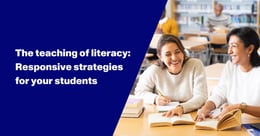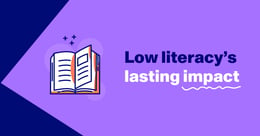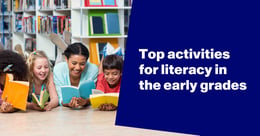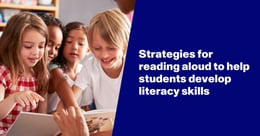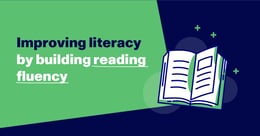
Balanced literacy vs. the science of reading: A discussion
In the conversation that swirls around balanced literacy vs. the science of reading, teachers and students are caught in the middle. How do we keep our ears to the ground so we can follow the research on what works, implement it effectively, and move forward together as we support the growth of a new generation of avid readers?
[READ: “How to teach reading: The K-12 guide”]
We sat down with Paper™ professionals Sarah Wilson and Jess Yau to understand what’s most important for teaching literacy today.
Wilson is a professional learning specialist who joined Paper in 2022 after five years of teaching preschool, second grade, and third grade in Pennsylvania and Ohio. She holds a bachelor’s degree in early childhood education and a master’s degree in language and literacy.
Following Paper’s acquisition of Readlee, Yau became a product manager and literacy lead at Paper. She has a master’s degree in mathematics and brings with her several years of educational experience as an instructional coach and teaching high school and college-level math. After realizing that insufficient reading skills were holding students back in Yau’s math classes, she became interested in working with edtech companies to help solve pressing challenges in teaching literacy.
How do you define balanced literacy vs. the science of reading?
The science of reading
Sarah Wilson: Essentially, the science of reading refers to utilizing what research and evidence tell us works in the process of learning to read. There is a massive emphasis on phonemic awareness, phonics, and spelling patterns.
But that doesn’t mean the science of reading leaves out other pieces that are important, including vocabulary and comprehension. It’s just about understanding that the foundation of phonics and spelling patterns should not be taught incidentally.
There needs to be a systematic approach for students to have structured and consistent learning in the classroom. But students should also engage with really rich texts. When it comes to fluency and comprehension, there should be repeated readings and continuous exposure to the same texts so students can build those other skills.
Jess Yau: When you say “science of reading,” a lot of people think: phonics. That’s at the forefront like Sarah mentioned, but there are other pieces in there that we shouldn’t forget. For instance, advocates often reference Dr. Hollis Scarborough’s Reading Rope.
The Advanced Education Research and Development Fund has a whitepaper on reading research initiatives that draws on the work of P. B. Gough and W. E. Tunmer to put it all in a formula: word recognition x language comprehension = reading comprehension.
Word recognition includes the phonics and phonemic awareness piece. It’s on everyone’s mind because it’s very tangible and concrete. But the linguistic side—how do you help students with vocabulary and knowledge acquisition so they can understand what they’re reading?—that part is less tangible.
You really need both pieces to get to reading comprehension, like Sarah was saying.
Balanced literacy
Wilson: Balanced literacy is a lot more difficult to nail down. It’s an approach that can vary from classroom to classroom because it has this sort of lack of inherent structure to it. Educators have to determine the best balance for their students on their own. How much scaffolding and support should I give versus how much independent practice should I give? This is quite different from the structured, systematic approach championed by the science of reading.
Essentially, students are learning to read much more contextually. They’re utilizing the meaning of a sentence or story as well as the structure of the sentence. And the visual piece focuses on understanding what the text says.
It’s a mixture of teacher instruction and other practices with a heavy emphasis on leveled small groups and independent learning time: think reading aloud, shared reading experiences, independent reading, guided reading, and word study.
In the education field, we’re leaning toward the science of reading, and we’re focusing on what the evidence says works best. But I think we need to be careful not to completely discount balanced literacy. There are aspects of this approach that help students find joy in reading and connect to the learning process more deeply.
What is most vital for teaching literacy today?
Wilson: Focus on what the research says works. It seems like an obvious answer, but I think we can, and should, all agree to put that at the forefront—utilize that structured and systematic approach to benefit the overwhelming majority of students.
But I think we also need to do that with an understanding that this decadeslong reading war has had casualties, and those casualties are the students and the teachers.
Students are entering new grades at wildly different knowledge levels. At the beginning of a school year, you can have 25 third graders who start out on 25 different stairs. The teacher is supposed to use a systematic approach that starts at stair 12, but not every student in that classroom is starting out on that step.
So I think we need to have a plan in place to deal with that. And we need to have some empathy for teachers. If a student started in preschool and kindergarten with a systematic approach, maybe we wouldn’t be here, but we are. On that note, I think we need to find a way to exist in harmony. We need to use a systematic approach, but we also need to understand that teachers are there to create an exciting learning process and environment for their students.
The most important thing is to let teachers share their knowledge. Give them the microphone, and let them tell everybody what’s happening in their classrooms. We invited teachers into our U.S. headquarters recently for our first Teacher Office Takeover, and I think my favorite quote from a teacher there was, “Nobody ever asks us.” That’s true. Nobody ever asks them.
Let them be a part of the research process. Let them share what really does work in the classroom.
Yau: At the Teacher Office Takeover, I talked to some middle school ELA teachers whose students were still struggling with decoding. They’re struggling with phonics, they’re struggling with that sound-spelling correspondence, and they’re at these varying levels like Sarah was saying.
Having a structured and sequenced approach to phonics is great if everyone is starting at the same place. But when you have students who are coming in from so many different entry points, it’s up to the teacher how to support all their students equally. That’s where the trick is. So I 100% agree about talking to teachers to get their insight and feedback.
Another thing I learned talking to teachers was how big of a challenge student apathy is. It seems like ever since the pandemic, students are very apathetic to learning. Can we pair those sequenced phonics lessons with activities that get students interested and engaged? That’s where pulling from all the different viewpoints is very beneficial.
[READ: “In-class activities for building literacy in the early grades”]
What role does fluency play in teaching literacy?
Wilson: I’ve always believed that fluency is a very vital piece of literacy development. I think it’s left behind sometimes. Basically, it brings together what we’ve been talking about—students recognizing and being able to read words and sounds on the one hand, and the comprehension part of reading on the other.
Fluency is vital for helping students make the jump from “learning to read” to “reading to learn.” Teaching fluency and having tools to help do that well was probably the biggest element that was lacking in my classroom. I had tons of tools and information about phonics. I had tons of reading comprehension and practice resources. But there were very few tools to support fluency.
Yau: Fluency is the bridge between word knowledge and linguistic knowledge. When students learn how to decode, they learn how to associate sounds and spelling. If they’re able to do that more accurately, and at a good pace with good prosody, then that’s a good proxy to show they’re actually comprehending what they’re reading. If students are reading and they’re using a lot of their short-term memory just to decode words, they’re not reading fluently. In that situation, they can’t use their working memory to understand and comprehend the text.
That’s why Paper Reading focuses on fluency. It’s a way to tie together everything that students have learned in terms of word knowledge, vocabulary, and content knowledge.
Wilson: And fluency is often reliant on repeated practice, which is hard to incorporate in a classroom. Do my students actually practice? How do they sound when they practice? With Paper Reading, there’s accountability and visibility for teachers so they can see how that practice is going instead of just hoping it’s working.
How is Paper Reading influenced by the science of reading?
Yau: The main focus of Paper Reading is deliberate reading fluency practice to drive independent reading in class.
A lot of times, practice in the classroom or as homework just looks like students flipping through pages, reading silently. But especially for the younger grades, the act of actually reading out loud provides accountability.
This is based on the experience of one of the co-founders of Paper Reading, Drew Madson. The whole semester went by, and there was one student in particular whom Drew hadn’t heard read once. So he thought to himself, “I can see how my students are doing with multiple-choice or fill-in-the-blank questions, but I don’t actually know how he’s reading.” That’s where Paper Reading comes in. Teachers can actually hear their students reading.
The tool also has other forms of scaffolding built in that are based on the science of reading.
For example, model reading is something that has been shown to help students become better readers, especially students who aren’t quite at the level where they understand the prosody or expression they should be using.
Vocabulary preview is another scaffolding tool that a lot of teachers use with Paper Reading assignments. After all, if a student doesn’t understand what a word is before they get to it—even if they’re able to decode it—they wind up using their short-term memory and won’t be able to put the word into context. But if they’re able to preview new words, hear how they’re pronounced, and understand what they mean ahead of time, then their reading process becomes much smoother, and they’re able to comprehend the text better.
Wilson: I want to echo that point about modeling. It’s a hugely important part of the science of reading: readers hearing other fluent readers modeling a text for them. With Paper Reading, that can be done en masse, because teachers can make a recording and then send it to every student in the class.
Also, even for people who are using a balanced literacy approach, they may listen to all of their students read and assess their skills, but they may have to do it all by hand, one by one. For my students, I did all the running records, marked their mistakes, and calculated their words correct per minute all by hand. That’s automated on Paper Reading, which would have saved me so much time.
Where do you think the conversation around how to teach reading is headed?
Wilson: I hope we’re at a point where we’ve picked a path. I’m optimistic we understand that the research and evidence coming out should be applied in our classrooms. I hope there’s a faster pipeline coming along as well. Oftentimes, research is done at a higher level in universities, but it takes 10 to 15 years to actually get used in a classroom with students.
Yau: In my mind, the debate is kind of done. There are people who are still very committed to one side or the other, but I think the next step isn’t to argue about what’s right.
I think it’s more about figuring out the next step we can take to actually solve the literacy crisis we’re seeing. What can teachers actually implement for their diverse classrooms? Because, as we’ve mentioned, not every student is at the same ability level right now.
Wilson: Another thing my master’s program focused on was making sure the texts we’re sharing with our students promote functional literacy. What’s going to be important in learners’ day-to-day lives? And also, what’s culturally relevant? What speaks to them? There’s this whole conversation that books should be mirrors and windows: Students should be able to see others’ perspectives, and they should also be able to see themselves in the books they’re surrounded by.
[READ: “More than just reading: Why low literacy has a lasting impact”]
This is a whole other conversation, but boys and girls often learn to read at different paces, and young boys can get left behind in the reading process. Some of the best moments in the classroom are sharing books with young learners and saying, “Hey, I see you in this book, and this is a really cool book.” So, for example, for boys in middle school—and particularly for young people of color—seeing themselves in a character who shares their interests helps them to see that literacy is for them. For anybody who struggles with reading, this kind of experience helps them think, “Reading isn’t just for the kids in my class who caught on really quickly. It’s for me, too.”
Looking for more information about teaching literacy? Check out “How to teach reading: The K-12 guide” today.

